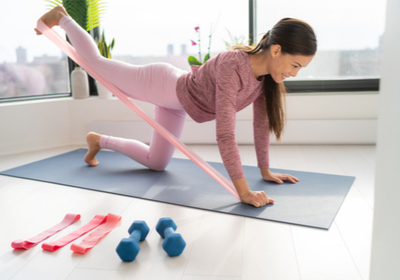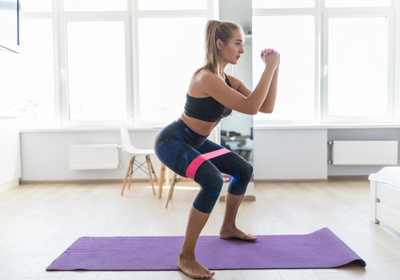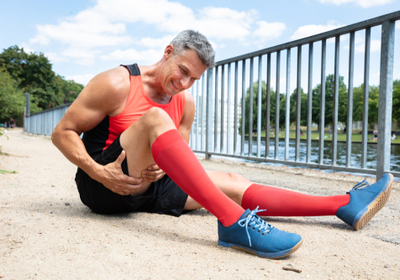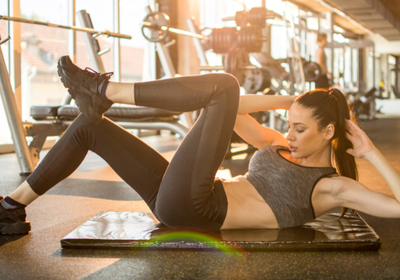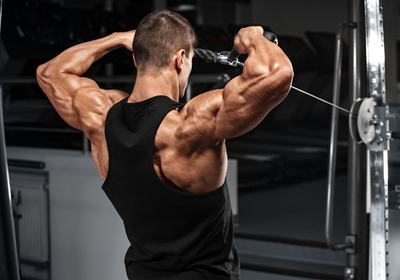VIDEO
Curtesy Lunge
- Core
- Legs
- Gluteus
- Hips
- Calves
Level:Beginner
Trainer:Ann Summer
Equipment:No Equipment
Curtesy Lunge
- Core
- Legs
- Gluteus
- Hips
- Calves
Level:Beginner
Trainer:Ann Summer
Equipment:No Equipment
Start with the standing position. Put your right leg backward and spot down.Then get back to the standing position and raise your right leg sideways. After, repeat it in the same way with the opposite leg.
save to ...
RECOMMENDED FOR YOU
Marc in Place
- Shoulders
- Gluteus
- Quads
Duaration: 00:30
save to playlist
Plank Knee to Elbow, Elbow to Knee Crunch, Plank Shoulder Touch
- Core
- Arms
- Back
Duaration: 00:15
save to playlist
Knee to Elbow Crunches, Crunch With Knees to Chest, Plank Knee Kick
- Core
- Biceps
- Triceps
Duaration: 00:27
save to playlist
Single Leg Squat Kickback With Plates
- Biceps
- Triceps
- Trapezius
Duaration: 00:15
save to playlist
Plank Knee to Elbow, Long Arm Vertical Crunches Variation, Side Elbow Plank Crunches Variations
- Core
- Arms
- Legs
Duaration: 00:15
save to playlist
Kettlebell Side Lunge
- Biceps
- Lower Back
- Gluteus
Duaration: 00:48
save to playlist
Single Leg Deadlift
- Core
- Lower Back
- Quads
Duaration: 00:30
save to playlist
Plank Leg Lifts Variation, Side Elbow Plank Leg Lifts Variation, Bridge Variation
- Core
- Arms
- Legs
Duaration: 00:15
save to playlist
Hanging Kick
- Core
- Abs
- Quads
Duaration: 00:16
save to playlist
Inchworm Variation
- Core
- Arms
- Abs
Duaration: 00:15
save to playlist
Walking Squats, Squat Jumps, Crunch Jumps, Standing Side Leg Lifts
- Core
- Legs
- Abs
Duaration: 00:15
save to playlist
Front Lunge Twist With Weights, Squat, Bicep Curls, Frog Crunches, Bent Over Row
- Arms
- Back
- Abs
Duaration: 00:15
save to playlist
Cross Plank
- Abs
- Biceps
- Upper Back
Duaration: 00:15
save to playlist
Plank to Squat Jump, Around the World Squat Jump, Jumping Lunges, Crunch to Single Leg Stand Up
- Core
- Back
- Abs
Duaration: 00:15
save to playlist
Side Lunge, Reverse Lunge, Scissor Legs Elbow Plank, Mountain Climbers, Plank V-Ups
- Core
- Trapezius
- Lower Back
Duaration: 00:15
save to playlist
Half Handstand Variation
- Core
- Arms
- Legs
Duaration: 00:15
save to playlist
Reverse Leg Lift
- Lower Back
- Gluteus
- Quads
Duaration: 00:16
save to playlist
Straight Arm Glute Bridge, Single Leg Bridge, Bridge
- Legs
- Lower Back
- Gluteus
Duaration: 00:15
save to playlist
Dumbbell Split Squat
- Lower Back
- Shoulders
- Gluteus
Duaration: 00:32
save to playlist
Bench Jump Variation, Plank Crunches Variation, Mountain Climbers, Squat Jumps, Reverse Plank Knee Tuck Variation
- Core
- Arms
- Legs
Duaration: 00:15
save to playlist
Pushups with Jumps, Reverse Pushups with Forward Leg Lifts, Downward Facing Dog, Jumps, Plank Jumps, Elbow Plank Variation
- Core
- Legs
- Abs
Duaration: 00:14
save to playlist
Leg Slide Pushup, Slide Bridge, Slider Burpees, Mountain Climbers
- Core
- Biceps
- Triceps
Duaration: 00:15
save to playlist
Frog Lunge
- Gluteus
- Quads
- Hamstrings
Duaration: 00:15
save to playlist
Jumping Jacks Squat
- Gluteus
- Quads
- Hamstrings
Duaration: 00:15
save to playlist
Jump Squat, Wide Pushup, Pushup Jack, Bicycle, Dumbbell Stepup
- Abs
- Biceps
- Upper Back
Duaration: 00:15
save to playlist
Squat Jumps
- Core
- Legs
- Gluteus
Duaration: 00:15
save to playlist
Extended Plank
- Core
- Abs
- Lower Back
Duaration: 00:18
save to playlist
Deep Squats
- Lower Back
- Gluteus
- Quads
Duaration: 00:16
save to playlist
Standing Cross Knee
- Gluteus
- Quads
- Hamstrings
Duaration: 00:15
save to playlist
Scissors Variation, Side Plank Crunches, Side Plank Hip Dips, Reverse Crunches
- Core
- Abs
- Biceps
Duaration: 00:15
save to playlist
Lunges, Side Squat, Plank to Squat Jump, Side Plank Variation, Pushups, Side Plank Hip Dips, Double Leg Lifts, Bicycle
- Core
- Arms
- Legs
Duaration: 00:15
save to playlist
Shoulder Touches
- Core
- Back
- Triceps
Duaration: 00:30
save to playlist
Side Plank High Knee Lifts, Side Elbow Plank Lifts
- Core
- Arms
- Abs
Duaration: 00:15
save to playlist
Dumbbell Thruster
- Wrists
- Biceps
- Triceps
Duaration: 00:34
save to playlist
Dumbbell Deadlift
- Core
- Trapezius
- Lower Back
Duaration: 00:53
save to playlist
Elbow Plank Reverse Leg Lifts, Single Leg Bridge, Reverse Leg Lifts
- Core
- Legs
- Abs
Duaration: 00:14
save to playlist
Plank Knee to Elbow Variation, Mountain Climbers, Elbow to High Plank, Plank Jumps
- Core
- Arms
- Legs
Duaration: 00:15
save to playlist
Barbell Hack Squat
- Triceps
- Gluteus
- Quads
Duaration: 00:41
save to playlist
Pushups, Burpees, Squat Jumps, Alternating Lunges, Jumping Jacks, High Knees, Squats
- Core
- Biceps
- Triceps
Duaration: 00:15
save to playlist
Pike and Tuck Burpees
- Core
- Back
- Biceps
Duaration: 00:15
save to playlist
Blog
The Kardashians set many beauty trends and one of those trends is gorgeous buttocks. So in this article, we will discuss how to build gluteus muscles and consequently look as hot as Kim, Kourtney, Khloé. Let’s start with the anatomy. The gluteus consists of three main parts:
Gluteus maximus muscle, which is the largest muscle of the body. It helps to maintain balance while walking and running, allows the leg to move outward, and it is also responsible for the tightened (or not so) shape of the buttocks.
The gluteus medius is partially overlapped by the gluteus maximus. It is located in the upper pelvis. It participates in the abduction of the leg to the side, lateral bending, and stabilization of the body during movement.
Finally, the gluteus minimus is located under the medius muscle. Together they are responsible for abducting the leg and stabilizing the body, as well as for forming the hip line.
Workouts for Gluteus
It's not that easy to build gluteus muscles, especially if you are limited in time. But if you work out at least three times a week and never give up, you will quickly reach your goal. In order to help you achieve your goal, we prepared the best exercises for developing muscles of the gluteal region. So here they come:
Barbell/dumbbell LungesThis exercise is ideal for those who are interested in pumping up the top of the buttocks and at the same time the back of the thigh. Begin the movement by bringing each leg one at a time forward. The thigh should be parallel to the floor and the knee should be at the right angle.
Barbell SquatThis is one of the basic exercises that help effectively build this muscle. From the starting position - legs apart, lower the pelvis just below the knees. Do not bend your lower back and make sure your knees do not surpass your feet. The wider your legs are apart, the greater the load on the buttocks.
Romanian deadliftsStand upright with your back slightly arched at the lower back. Holding the dumbbells in your hands, bend over, pulling your pelvis back. Once you reach the spot just below your knees, return to the starting position.
Dumbbell Split SquatsThe exercise is performed with a straight back, with one leg taking a step forward and throwing the other one on a stand from behind. Squat and do the exercise for both legs.
Back LungesStart in a standing position, take a wide step back and lower into a lunge. Return to the starting position and repeat the exercise for the other leg. Do 20-30 repetitions for each leg, making sure that your knees are bent at right angles and do not protrude beyond your toes. It is important to take steps exactly backward while maintaining rhythm and balance.
Wrapping Up
Gorgeous buttocks are everyone’s dream come true and, luckily, it’s not that difficult to develop these muscles if you know the right workouts. So why don’t you use our guides and start moving toward your goal now?
Read more
Everyone wants to have beautiful hips. Unfortunately, it's not that easy to keep it in a nice shape. We have some exercises that will definitely help you work your hips out.
Best Workouts for Hips
Beautiful hips require some effort, so let’s take a look at some exercises for hips.
CrossingsThis deep inner thigh stretch will improve your hips and give you a boost of energy. Spread your legs wide with your feet facing outward. Bend your knees and lower yourself into a squat. Put your hands on your hips just above the knees, deepening the squat and stretching even more. Jump up and place your right foot in front of your left one, while landing, you should straighten and cross your legs. Return to the starting position and repeat the exercise with the other leg. Repeat the exercise, alternating legs, as many times as you can, for at least 40 seconds.
Knee squatsSquats with knees together are much better than regular squats for strengthening the inner thighs, quads, and hamstring. And in order not to waste your time, you can work on your hands at the same time. Stand up straight with your feet together. Take dumbbells, bend your elbows and touch the shoulders with the dumbbells. Do a squat with your knees bent and your hips back as if you were about to sit in a chair. Keep your legs together during the entire exercise. The weight should be on your heels. Now stretch your arms up. Return to the starting position without putting your weight on your toes. Do 10 reps.
Elbow plank with raising legsAdd leg raises to your regular elbow plank to improve the hips. Lie on your side, bend your right arm at the elbow and lean on it. Extend your legs so that your body becomes one straight line. Try to rest only on the outer edge of your right foot. Place your left hand on your thigh. Feel your spine stretch and your abs tighten, then lift your left leg just above your hip. Slowly lower it back down. Do not bend at the waist or lean on your shoulder, keep your weight on your elbow. Do about 15 reps for both sides.
Swings with bent legsThis is one of the most popular exercises for strengthening the buttocks and hips. It is suitable for everyone, does not require additional equipment, and does not involve the spine. With the help of swings, the back, front, outer and inner thighs are worked out - combo. Start in plank, palms - under the shoulders, knees - under the pelvis, keep the position of the back. On the exhale, we swing our leg, pushing the heel up; we perform 20 repetitions on each leg and four sets total.
Side lungesIf you are doing this exercise for the first time, you will not need dumbbells - first master the movements of the legs. Take a dumbbell in your right hand, lunge to the left, lowering your right hand to your right leg. Lower your hips as low as possible, resting on your heels. The toes are facing forward, the angle of the bent leg is 90 degrees. Pushing off with your left foot, go into a courtesy pose: the left leg goes back, and the right one goes forward. Raise your arm with the weight up. Both legs face forward. Keep your hips and legs taut. Repeat without returning to the starting position, but immediately moving from a squat to a side lunge. Do three sets of 10 reps, then switch sides.
Final Word
Beautiful hips are a reality if you know what to do, so why don’t you give these exercises a try and see everything yourself?
Read more
The hamstrings are often underestimated. Usually, training focuses on the quads and calves, but the hamstrings seem to be less important. However, it should be remembered that neglecting any muscle has aesthetic and health consequences that you can avoid by working with it well. The reason you shouldn't forget about these muscles isn't just because of the symmetry and the look of your body. A weak hamstring is one of the most common causes of injuries most professional athletes have.
Best Workouts for Hamstrings
The best way to strengthen your hamstrings is, of course, exercising. So let’s talk about these workouts.
Barbell 90The main benefit of this exercise is that you don't need lots of equipment, just a barbell. Start in a standing position with a barbell on your shoulders, keeping your back straight at all times. Bend your knees slightly, stretch your glutes, and bend forward 90 degrees. Then inhale and return back to the starting position. In addition to the hamstrings, this exercise will also strengthen your glutes and back.
HyperextensionHyperextension is a great exercise for the hamstrings, as well as the muscles in the lower back and glutes. Sit comfortably on the hyperextension machine with your heels firmly resting on the platform at the bottom of the machine. Cross your arms over your chest or behind your head. Smoothly lower yourself down until you feel a stretch in the muscles of the lower back and hamstring while inhaling. Without delay at the bottom point, straighten to the level of the starting position, exhaling. Then return to the starting position. Throughout the exercise, keep your head in line with the body, keep your back straight.
Tights upThis exercise can be performed on two horizontal bars on the playground, or simply put your feet on a chair or bench. We will describe the home workout option.
Sit on the floor with your feet on the chair. Raise the body on your hands so that the tights are up in the air. Bend your knees and lift your tights up so that your body is parallel to the floor. Do 7-8 reps.
One foot and dumbbellsThis exercise works well but requires a nice sense of balance. Take dumbbells in your hands, take one leg back and do not lower it to the floor until the end of the exercise. After that get to the previous position. Repeat this exercise a few times until you are tired.
Final Word
Hamstrings might seem insignificant but it doesn’t mean that you can skip working on these muscles. In fact, strong hamstrings will protect you from many injuries. So do not hesitate and start working on these muscles right now.
Read more
The path to beautiful abs should not start with the question 'How to strengthen abdominal muscles?' The thing is that the visual image of a flat stomach depends on the percentage of body fat. This means that the way your abs will look not only depends on the number of crunches you do but on the quantity and quality of your food. So today we are going to talk about the tips for getting gorgeous abs.
Abs vs Food
Nutrition is extremely important for getting abs. In fact, your coach will probably give individual nutrition recommendations after testing, but there is one universal rule that everyone should follow - eat healthy food. In particular, you should avoid eating bakery, sugar-containing foods, and salty snacks. On the contrary, you have to eat more vegetables, fruits, herbs, nuts and seeds, as well as meat or other high-protein foods.
Getting Started
Before starting a workout, it is important to obtain data on your body condition. This means that the best place to start is fitness testing. Your trainer will ask you some questions in order to learn about your lifestyle, test your ability to move, and measure you. Then the coach will recommend the activities that will be safe and effective for you.
Popular Abs Workouts
It is believed that the best ab exercises are the training of the rectus abdominis muscles, which perform the function of flexing the body and keeping it upright. But this is just the tip of the iceberg. You also want to work on the deep muscles, which are part of your core and include the muscles of the abdomen, back, thighs, and buttocks. Their function is to help the body maintain posture and balance in an upright position. As a matter of fact, if your core is not strong enough, you will most likely experience discomfort while doing other exercises. Strengthening the core should be your top priority and you can do that with the help of TRX loops, plank and its variations, as well other bodyweight exercises.
Exercises for Strengthening Core and Abs
As we have mentioned above, to have gorgeous abs, you have to make sure you not only work on your abdominal muscles but on your entire core. So here are some exercises for improving all these muscles:
Diagonal twists
Plank
Pushups
Plank push-ups
Crunches
Leg lifts from lying position
Wrapping Up
As you can see, getting gorgeous abs is totally possible if you know how to work on them. Healthy nutrition and regular exercises will help you sculpt the body of your dreams, so do not hesitate and start going toward your dream now.
Read more
Before choosing the best exercises for the deltoid muscles, you should learn their structure. These muscles consist of three parts, and in order to achieve good results, you need to pay attention to each of them to ensure their harmonious development. And in this case, there is a whole set of exercises aimed at parallel and sequential working out of all ligaments of deltoid muscles.
Best Exercises for Deltoid Muscles
In order to have strong deltoids, you have to regularly train them, which is why we suggest you take a look at these exercises for deltoid muscles.
Sideways dumbbellsIf you are interested in building the back delta of the shoulder, then this workout is what you need. This exercise extensively involves not only the deltoid but also the trapezius muscles. Take the dumbbells with a neutral grip and lean forward slightly, keeping your back straight, and the dumbbells should now be raised to the ear level. To do this, you need to bend your elbows and take the starting position by slowly lowering your arms.
Front liftThrough this exercise, you can achieve excellent upper muscles and the muscles of the trapezium. Take the dumbbells while being in a sitting position. Lower your hands. Now you should lift the dumbbell to the point parallel with the floor. At the same time, the arm remains straight. When you reach shoulder level, stop. Lower the dumbbell in the same way. Do the same with the other hand.
Lifting sidewaysExperts recommend carrying out these exercises for effective pumping of the lateral deltoid muscles. The effectiveness of the exercise depends on the correctness of the exercise, therefore strictly follow these instructions: Stand up straight with dumbbells in your hands. Now slowly lift the dumbbells. Once the dumbbells are at your shoulder level, you should stay in this position. After that, slowly lower our arms, thereby returning to the starting position.
Barbells pressTake the shell on your chest, bring your elbows forward, tighten your abs, buttocks, and legs. Lift the bar up, lower it back and repeat. When the bar passes your face, do not lift it upper, but put it to yourself: this way the bar will go along the optimal trajectory. If at the top point the projectile remains in front of the body, and not above it, the load on the lower back increases. Therefore, try to take the barbell behind your head. Do three to five sets of six to eight reps.
Handstand push-upsThis exercise movement itself repeats the barbell press up in a reduced range. Stand in a handstand with your feet on the wall. Bend your elbows, lower yourself and touch the floor with your head. Put yourself back and repeat. Place your head on the floor more carefully (careless movements can damage your neck). To make the exercise easier, place something under your head, such as a rolled blanket or several thick books. To complicate things, place firm support under your arms. Perform as many times per set as you can. Do 3-5 approaches, depending on how you feel.
Wrapping Up
Developed deltoid muscles will make you look athletic and simply stunning, so if you dream of a beautiful body, make sure to do some of these exercises.
Read more
SAVE TO ...

